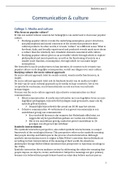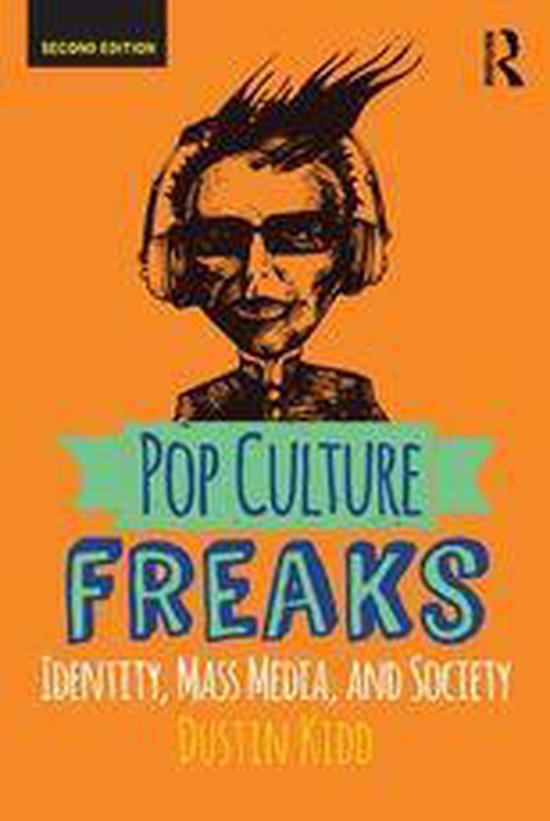Bachelor jaar 2
Communication & culture
College 1: Media and culture
Why focus on popular culture?
Er zijn een aantal redenen waarom het belangrijk is om onderzoek te doen naar popular
culture.
Studying popular culture reveals the underlying assumption, power structures,
and philosophical and moral constructs of the society that produces those
cultural products. In other words, it reveals “culture” in a different sense. What is
forefront, daily, and broadly experienced and produced reveals much more about
a culture than the relatively rare ritualistic elements associated with culture.
Studying popular culture gives us an accessible vehicle through which to explore
philosophical and moral questions, as well as the functioning of society on a
smaller scale (fandom, consumption), through which we can make larger
assumptions.
Het bestuderen van de producenten en hun intenties, de content en de receptie van
popular culture en de mogelijke consequenties, vertelt ons dingen over onze cultuur.
Studying culture: the socio-cultural approach
De socio-cultural approach trekt de sociale context, waarin media functioneren, in
twijfel.
De socio-cultural approach trekt ook de bindende kracht van de media in twijfel.
De visie van de socio-cultural approach op de media en haar content is: het is een
(re)productie van kennis, een levensoriëntatie en ook een bron van culturele
herinneringen.
Vormen van the socio-culture approach zijn cohesive communication en ritual
communication.
Ritual communication media zijn verbonden met ons dagelijkse leven en onze
dagelijkse gedragingen, bijvoorbeeld bij dingen zoals gewoontes, maar ook bij
speciale gebeurtenissen.
Iemand kijkt bijvoorbeeld elke avond om 20:00 naar het nieuws.
Cohesive communcation verbintenis of een gevoel van samenzijn is een
onzichtbaar gevolg van communicatie.
Een voorbeeld hiervan is dat wanneer het Nederlands elftal wint, we
zeggen dat wij het goed hebben gedaan, we voelen ons verbonden.
Het is een onzichtbaar gevolg, omdat het gevoel onzichtbaar is. De
gevolgen van dit gevoel zijn zichtbaar.
Symbolic interactionism
The symbolic interaction perspective, also called symbolic interactionism, is a major
framework of the sociological theory. This perspective relies on the symbolic meaning
that people develop and build upon in the process of social interaction. Although
symbolic interactionism traces it origins to Max Weber’s assertion that individuals act
according tot heir interpretation of the meaning of their world, the American
philosopher George Herbert Mead introduces this perspective to American sociology in
the 1920s.
Symbolic interaction theory analyses society by addressing the subjective meaning that
people impose on objects, events, and behavior. Subjective meanings are give primacy
because it is believed that people behave based on what they believe and not just on
1
, Bachelor jaar 2
what is objectively true. Thus. Society is thought to be socially constructed through
human interpretation. People interpret one another’s behavior, and it is these
interpretations that form the social bond. These interpretations are called “definition of
the situation”
Er zijn volgens Blumer (1969) 3 kernpunten van symbolic interactionism.
Humans act towards things on the basis of the meaning they ascribe to those
things.
The meaning of such things is derived from, or arises out of, the social interaction
that one has with others and the society.
These meanings are handled in, and modified through, and interpretative process
used by the person in dealing with the things he/she encounters.
Een voorbeeld van symbolic interactionism is:
Why would young people smoke cigarettes even when all objective medical
evidence points to the dangers of doing so? The answer is in the definition of the
situation that people create. Studies find that teenagers are well informed about
the risks of tobacco, but they also think that smoking is cool, that they will be safe
from harm, and that smoking projects a positive image to their peers. So, the
symbolic meaning of smoking overrides the facts regarding smoking and risk.
Transmission or ritual view (Carey)
Er bestaan twee verschillende kijken op communicatie.
Transmissional view communication is the transmission of signals or
messages over distance for the purpose of control.
Terms imparting, sending, transmitting, or giving information to other.
Een voorbeeld binnen de transmissional view is het w-w-w-w-w model.
2
, Bachelor jaar 2
According to Carey (1989) the transmission view of communication is the
commonest in out culture - perhaps in all industrial cultures - and
dominates contemporary dictionary entries under the term. It is defined
by terms such as imparting, sending, transmission, or giving information
to others. It is formed from a metaphor of geography or transportation …
in the idea of transmission: communication is a process whereby
messaged are transmitted and distributed in space for the control of
distance and people.
Ritual view communication is directed not toward the extension of messages
in space but toward the maintenance of society in time.
Terms sharing, participation, association, fellowship, or possession of a
common faith.
According to Carey (1989) the ritual view of communication is that in a
ritual definition, communication is linked to term such as sharing,
participation, association, fellowship or the possession of a common faith.
This definition exploits the ancient identity and common roots of the
terms commonness, communion, community and communication. A ritual
view of communication is directed not toward the extension of messages
in space, but toward the maintenance of society in time; not the act of
imparting information but the representation of shared beliefs.
Culture as shared meaning
Shared meaning is the meat and bones of culture. Meanings range from our highest
beliefs about god and the sacred to our everyday tastes about food and fashion. It is the
political ideologies we fight over and the everyday assumptions we take for granted.
These meanings are structured into our language and the various other ways that we
communicate. Some meanings are relatively fixed and hard to change; others are
constantly being debated and negotiated. Culture is produced within families,
neighbourhoods, schools, and churches and it is also produced by the entertainment
industry. The mass media floods our homes and lives with stories about the human
experience, and each story includes a set of claims about what the world means”
Shared meanings keep us together.
What is culture?
Culture is everything what people have, think and do.
Some things you can see (top of the iceberg) and some things we can’t see
(bottom of the iceberg, the part that is under the water).
Er zijn verschillende definities van cultuur.
“Sometimes culture is defined in a very narrow sense as “the arts” or some sort of
fashionable refinement. Another definition of culture is much more expansive,
however. In this broader sense, culture is a particular way of life and how that life
is acted out each day in works, practices, and activities. Thus, we can talk about
Italian culture, Javanese culture, or the culture of the ancient Greeks”
“an historically transmitted pattern of meanings embodied in symbols, a system
of inherited conceptions expressed in symbolic forms by means of which men
communicate, perpetuate, and develop their knowledge about
“culture is the expressed and shared values, attitudes, beliefs, and practices of a
social group, organization, or institution”
Culture is the pervasive and shared beliefs, norms, values, and symbols that guide
everyday life, transmitted by symbols, stories and rituals, often taken-for-granted.
3
, Bachelor jaar 2
Cultural differences: how do they show
Conclusion: culture is a complex term- but in entails both everyday manifest and
tangible aspects (what we wear, what we eat) as well as more intangible, latent aspects
(what our ideals are, what we believe). Per culture these manifest and latent aspects of
culture can vary immensely.
2-way connection between people and culture
volgens Berger en Luckmann bestaat cultuur uit 3 punten, die tegenstrijdig lijken
society is a human product. Society is an objective reality. Man is a social product.
Culture is a human. Historic product.
Externalisation (solution in actions of a problem).
Culture is an objective reality outside of us.
Objectivation (we are born into a culture with institutions already in
place).
Culture is a subjective reality inside of us.
Internalisation (socialisation into our culture).
Culture is us: in us, outside of us and because of us paradox: dialectial process of
people and culture.
Culture and change
Er veranderd veel in een cultuur. Een voorbeeld hiervan is trouwen.
Externalisation trouwen was puur om kinderen te rechtvaardigen door een
man aan een vrouw te binden (ongeveer 4000 jaar geleden).
Objectivation dit werd getransformeerd in een institutie met onze eigen
regels, plichten en verwachtingen.
Internalisation een verwacht patroon in onze maatschappij dat wanneer je
voor een lange tijd samen bent, het wordt verwacht je samen gaat settelen en
gaat trouwen, om zo samen te kunnen leven en het nageslacht te rechtvaardigen.
Er zijn 3 redenen voor een verandering in een cultuur.
De ideeën van een cultuur komen niet meer overeen met de realiteit.
Eerst was alleen heteroseksualiteit normaal, nu zijn alle vormen van
seksualiteit normaal.
Oplossingen van de vorige generaties werken niet langer meer.
Trouwen om alleen kinderen te rechtvaardigen.
Competitie van andere modellen.
Monogamie en polygamie.
Mass communication, Culture and Media literacy - Baran
De media is zo opgenomen in onze dagelijkse levens, dat we soms niet eens doorhebben
dat het er is.
Communication
In zijn simpelste vorm is communicatie het uitzenden van een bericht van een bron naar
een ontvanger.
Harold Lasswell (1948) beschreef communicatie door antwoord te geven op de
volgende vragen:
Who?
Says what?
Through which channel?
To whom?
With what effect?
4





